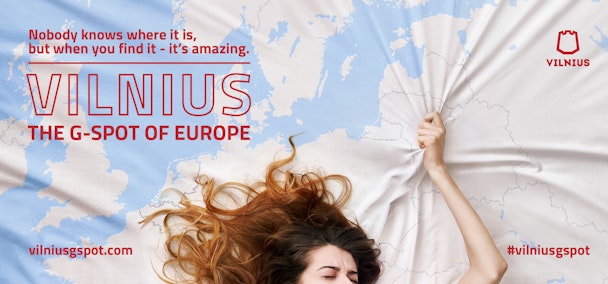Behind Vilnius’ ‘G-spot’ campaign: the student project that lay dormant for two years
‘The G-spot of Europe’, the official Lithuanian tourism campaign attracting media attention from around the world, was originally crafted by advertising students. The idea was two years in existence before the official development agency of Vilnius retrieved it from the depths of the internet and made it happen.

Vilnius's latest campaign compares the city to a G-spot
The suggestive creative of ‘Vilnius: The G-spot of Europe’ has so far been covered by publications from the Daily Mail to Quartz. The campaign even landed its own segment on US talk show Last Week Tonight, on which host John Oliver exclaimed “That’s real! That is real” after a clip of the video campaign was shown.
‘G-spot’s creative assets all riff upon the central double entendre: that ‘nobody knows where [Vilnius] is but when you find it – it’s amazing’. The main campaign image features a woman clutching a map of Europe in pleasure (her left grasping where Vilnius is located) while the videos comprise tourists experiencing gratifying moments as they stare at the city’s famous landmarks to a distinctly porno soundtrack.
“The primary challenge that we’ve encountered with positioning Vilnius as a tourist destination is related to awareness – not enough people know about our city,” Inga Romanovskienė, Go Vilnius’ director, told The Drum. “So, raising awareness is the main goal we needed to address.
“We understand that a single campaign will not solve this problem entirely and that consistent work and further investment is necessary; however, even that would not guarantee complete success in a highly competitive and ‘noisy’ tourism advertising environment. Therefore, catching people's attention with a message is a great challenge.”
The solution presented itself from an unlikely location: an old portfolio of student work.
Jurgis Ramanauskas, now an art director of DDB Vilnius, recalled: “Two years ago, while still studying at Atomic Garden Vilnius, we [Ramanauskas, Skaistė Kaurynaitė and Ugnius Mikšta] received a brief to promote Vilnius as a not well-known tourist destination with an integrated campaign. We came up with the concept, got it approved and executed it with borrowed equipment very cheaply for our portfolios.
“Nearly two years later, on Vilnius's birthday, someone on the internet found the print mock-up and used it to congratulate the city on the occasion. It quickly caught attention and went viral in Lithuania and a little beyond. At that point, Go Vilnius, the official development agency of the city decided to make it happen. That’s the story.”
Go Vilnius brought the former students into the office, and alongside Lithuanian advertising photographer, Tomas Kauneckas, the new team created the work in the space of six months. The risqué nature of the campaign somehow feels less surprising, knowing that it was produced by the “coffee infused minds” of three students.
“We started joking around and discovered the analogy which clicked with us instantly,” said Ramanauskas. “As for the insight, we realised that it's true from our experiences abroad when we kept getting blank looks after telling people we're from Vilnius.
“Also, we've noticed that foreigners who came to our city or even decided to stay here were very satisfied with their experience. And of course, the seed for all of it was laid out in the brief.”

Romanovskienė is satisfied with reaction to the campaign so far, although is aware its bawdy nature has also divided opinion. Some commentators slated it for launching just before the Pope embarked on his visit to Lithuania, worrying its sexual references would cause offence to the Catholic Church.
But, as Romanovskienė pointed out, the campaign has only been rolled out in Berlin and London this summer – not Lithuania – and will end before the pontiff lands.
“Overall, the response to the campaign has been mostly positive, praising the campaign as ‘bold’ and as one that stands out from other campaigns in the field,” she said. “Most importantly for us, it really got noticed, which was our goal.”

